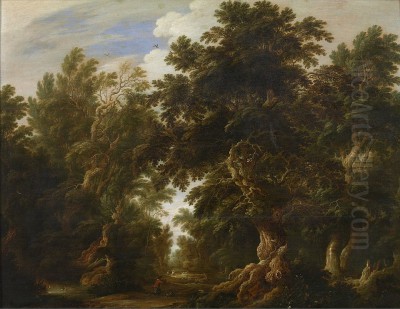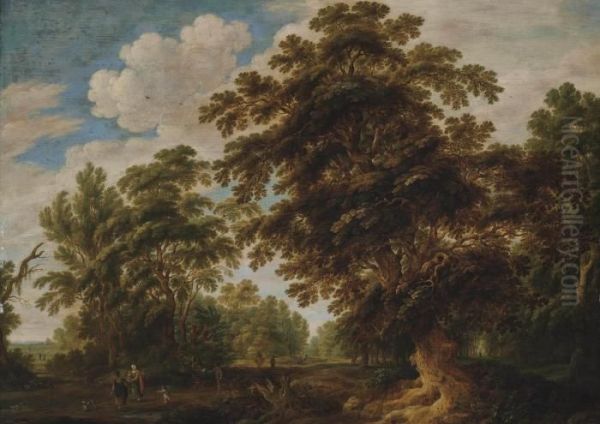
Alexander Keirincx stands as a significant figure in the rich tapestry of 17th-century Flemish and Dutch landscape painting. Born in the bustling artistic hub of Antwerp in 1600 and passing away in Amsterdam in 1652, Keirincx carved a distinct niche for himself within the Baroque era. He is primarily celebrated for his evocative and meticulously detailed forest landscapes, often populated with small figures that add narrative or genre interest. Furthermore, his career took a unique turn with a commission from the English monarchy, leading to a series of pioneering topographical 'portraits' of castles and estates in Britain. Bridging the traditions of his native Flanders with the evolving tastes of the Dutch Republic where he spent much of his career, Keirincx's work offers a fascinating study in artistic development and cross-cultural exchange.
Early Life and Training in Antwerp
Alexander Keirincx entered the world in Antwerp, a city renowned for its vibrant artistic production and the legacy of masters like Peter Paul Rubens. The exact details of his earliest training remain somewhat obscure, but it is widely believed that he studied with, or was heavily influenced by, Abraham Govaerts, another Antwerp painter known for his small-scale, finely executed woodland scenes. The influence of Govaerts is palpable in Keirincx's early works, which often share a similar detailed rendering of foliage and a somewhat Mannerist sensibility in the arrangement of trees.
In 1619, Keirincx achieved a crucial milestone in his professional life by becoming a master in the Antwerp Guild of Saint Luke. Membership in the guild was essential for practicing independently as an artist, selling work, and taking on apprentices. This recognition, achieved at the relatively young age of nineteen, attests to his considerable talent and the quality of his training. Three years later, in 1622, he married Clara Matthijssen (also recorded as Mattheus or Matthusen) in Antwerp, establishing his personal and professional life within the city's artistic community. During these formative years, he would have been keenly aware of the dominant trends in Flemish landscape painting, particularly the work of artists like Jan Brueghel the Elder and Gillis van Coninxloo, whose innovations in depicting dense, atmospheric forests set a high standard.
Relocation and Career in the Dutch Republic

Despite his roots and initial success in Antwerp, Keirincx, like many artists from the Southern Netherlands during this period, sought opportunities elsewhere. Political and economic factors, along with artistic prospects, often prompted relocation. By the mid-1620s, Keirincx had moved north to the Dutch Republic. He is documented as being active first in Utrecht around 1628, and later, more permanently, in Amsterdam from about 1636 until his death.
Utrecht was a significant artistic center in its own right, particularly known for the Utrecht Caravaggisti and for painters specializing in Italianate landscapes. It was here, or possibly slightly later in Amsterdam, that Keirincx established one of the most important professional relationships of his career – his collaboration with Cornelis van Poelenburch. Amsterdam, as the burgeoning economic powerhouse of the Dutch Republic, offered a dynamic art market and diverse patronage. Keirincx seems to have thrived in this environment, continuing to develop his landscape style while also engaging in other activities, such as art dealing, particularly later in his life. His move reflects a broader pattern of artistic migration and the interconnectedness of the art worlds in the Low Countries.
The Keirincx Landscape: Style and Evolution
The quintessential Keirincx painting is a forest interior. He possessed a remarkable ability to capture the textures and forms of trees, rendering bark, leaves, and branches with meticulous care. His early works, influenced by the Flemish tradition exemplified by Govaerts and Coninxloo, often feature densely packed woods, intricate foliage, and a relatively shallow sense of space, sometimes incorporating Mannerist elements like elegantly twisting tree trunks. These early forest scenes frequently adhere to the established three-color scheme (brown foreground, green middle ground, blue background) common in landscape painting of the time.
However, as his career progressed, particularly after his move to the Dutch Republic and his exposure to different artistic currents, Keirincx's style evolved towards greater naturalism and atmospheric depth. His compositions became more open, allowing for views into the distance, and his handling of light grew more sophisticated. He masterfully depicted dappled sunlight filtering through the canopy, creating convincing effects of light and shadow that added volume and mood to his scenes. While greens and browns remained dominant in his palette, reflecting the woodland subjects, his application became broader and more suggestive of real atmospheric conditions. He shared this focus on detailed woodland scenery with contemporaries like Roelant Savery, though Savery often included more exotic elements.
Collaboration with Cornelis van Poelenburch

One of the defining features of Alexander Keirincx's career was his frequent and successful collaboration with the Utrecht painter Cornelis van Poelenburch (c. 1594-1667). Poelenburch, who had spent time in Italy, specialized in small-scale, smoothly painted Italianate landscapes, often featuring mythological or biblical figures, particularly nudes, set in classical ruins or idyllic pastoral settings. His style was influenced by German artist Adam Elsheimer, known for his small, poetic landscapes on copper.
The partnership between Keirincx and Poelenburch exemplifies a common practice in 17th-century Netherlandish art, where specialists would combine their skills. Keirincx, the master of the landscape setting, would paint the detailed trees, foliage, and atmospheric background, while Poelenburch would add the figures, known as 'staffage'. This division of labor allowed each artist to focus on their strengths, resulting in works that seamlessly integrated detailed natural environments with elegant, often narrative, figure groups. Their collaborative works often depict scenes like nymphs bathing in forest pools, biblical encounters in wooded settings, or mythological episodes unfolding beneath Keirincx's meticulously rendered trees. Records indicate that during their time in London, they lived near each other, suggesting a close working relationship. This collaboration significantly impacted Keirincx's output, adding a popular narrative dimension to his landscapes.
Royal Patronage: The English Sojourn
A particularly noteworthy episode in Keirincx's career was his journey to England, likely between 1639 and 1641. He was summoned by King Charles I, a monarch renowned for his sophisticated taste and extensive art patronage, which famously included Anthony van Dyck and attracted visits from Peter Paul Rubens. Charles I commissioned Keirincx to undertake a specific and ambitious project: to paint a series of views – essentially landscape 'portraits' – of the King's castles and palaces in England and Scotland.
This commission was significant for several reasons. It demonstrated Keirincx's high reputation, extending beyond the Low Countries to attract royal attention in England. It also marked a shift, albeit temporary, in his subject matter towards topographical accuracy. He was tasked with depicting specific locations, requiring careful observation and representation of architecture and its surrounding landscape. Ten such views were commissioned, intended to document the King's properties across his northern kingdom. These works stand as early examples of detailed topographical landscape painting in Britain by a continental artist. The resulting paintings provided valuable records of these sites in the mid-17th century. This period also saw other artists like Wenceslaus Hollar creating topographical prints and drawings in England, highlighting a growing interest in accurate depictions of place.
Notable Works and Themes
Among the most famous works resulting from the English commission is the Distant View of York (c. 1639, Tate Britain). This painting showcases Keirincx's ability to combine his skill in landscape painting with the demands of topographical representation. The city of York, with its prominent Minster, is depicted in the distance, nestled within a panoramic landscape rendered with careful attention to detail and atmospheric perspective. It exemplifies the series commissioned by Charles I, blending architectural portraiture with expansive natural scenery.
Beyond the English views, Keirincx's oeuvre includes numerous forest landscapes, often featuring narrative themes. The Miracle of Saint Hubert (various versions exist) is a good example of his integration of religious subjects within his characteristic woodland settings. The scene, depicting the legendary conversion of Saint Hubert during a hunt, allows Keirincx to display his mastery of forest interiors, complete with detailed trees and dramatic lighting filtering through the leaves, creating a suitably mystical atmosphere for the miraculous event.
Works simply titled Forest Landscape or similar, sometimes featuring hunters, travelers, or mythological figures (often added by Poelenburch or another collaborator), form the core of his output. A painting like The Hunt demonstrates his ability to create dynamic scenes within the forest, capturing the movement of animals and hunters beneath towering trees. These works highlight his consistent interest in the interplay between nature and human or animal activity, rendered with his signature detailed style.
Later Years and Legacy
After his return from England, Keirincx settled definitively in Amsterdam, which remained his base until his death in 1652. In his later years, alongside his painting activities, he also became increasingly involved in the art trade, acting as an art dealer. This was not uncommon for artists at the time, allowing them to leverage their expertise and connections within the art market. His connections extended to prominent collectors and patrons within the Dutch Republic, including Frederik Hendrik, Prince of Orange, and his wife Amalia van Solms, whose inventories list works by Keirincx.
Alexander Keirincx's artistic legacy lies primarily in his contribution to landscape painting. His meticulous rendering of trees and foliage, combined with his developing sense of atmospheric realism, positioned him as an important figure bridging the earlier Flemish traditions of Coninxloo and Brueghel with the great Dutch landscape painters who followed. Art historians have noted that his depiction of gnarled, characterful trees and his interest in light effects within the forest foreshadow aspects found in the work of later masters such as Jacob van Ruisdael and Meindert Hobbema. While perhaps not as revolutionary as some of his contemporaries, Keirincx perfected a particular type of forest landscape that was highly appreciated in his time. His English topographical views also represent a significant, though less extensive, part of his contribution. He remains recognized for his technical skill, his successful collaborations, particularly with Poelenburch, and his distinctive vision of the woodland interior. His contemporary, the Flemish landscape painter Lucas van Uden, explored similar themes, offering a point of comparison within the broader Antwerp school tradition. Keirincx's work continues to be valued for its detailed beauty and its place within the evolution of Netherlandish landscape art.